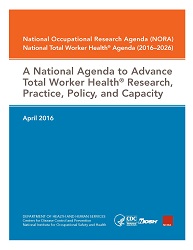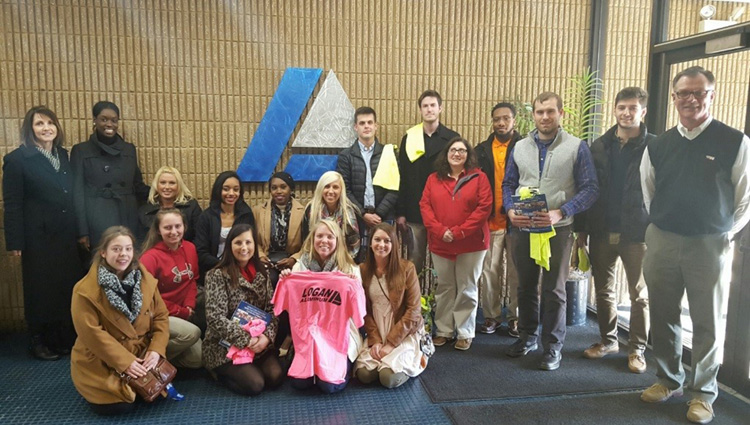Total Worker Health in Action: May 2016
Volume 5 Number 2 May 2016
Managers’ Buzz
Anita L Schill, PhD, MA, MPH, and L Casey Chosewood, MD, MPH

Did you get it or miss it? Despite our best efforts—including tweets, a press release, an email blast and a LinkedIn post—you may have missed the NIOSH Office for Total Worker Health’s recent release of the National Total Worker Health Agenda and NIOSH Response to Summarized Stakeholders’ Comments. The Agenda outlines research directions for NIOSH and the Nation for the next decade. With strategic goals spanning four key areas—research, practice, policy, and capacity-building—the Agenda aims to enhance our knowledge of the Total Worker Health (TWH) approach to advancing worker safety, health and well-being. Learn more about the National Total Worker Health Agenda and NIOSH Response to Summarized Stakeholders’ Comments by reading Updates from the NIOSH Office for TWH.

If you’ve ever been curious about the concept of “health climate”, you won’t want to miss the article by Dr. Zandra Zweber, an industrial research psychologist specializing in health climate. Dr. Zweber explains that health climate stems from the idea that people are highly influenced by their social environment, including their workplaces. Read more about Dr. Zweber’s take on health climate and how it can help organizations complement their approaches to workplace safety, health, and well-being, in the Total Worker Health Exclusive.
As always, you can keep track of the latest TWH news, events, and more by joining the conversation on Twitter (@NIOSH_TWH), on the NIOSH Total Worker Health LinkedIn Group, or by email at twh@cdc.gov.

- Managers’ Buzz
- Total Worker Health Exclusive
- Updates from the NIOSH Office for Total Worker Health
- Updates from the NIOSH National Center for Productive Aging and Work
- Updates from the NIOSH Centers of Excellence for Total Worker Health
- News from Our TWH Affiliates and Partners
- New Publications and Resources
- Conferences, Webinars, and Trainings
- Contributors
Total Worker Health Exclusive
Can the workplace be a “social health network?”
Zandra Zweber, Ph.D.
University of Connecticut & Center for the Promotion of Health in the New England Workplace (CPH-NEW) Alumni Research Affiliate and Industrial Psychologist specializing in workplace health climate
With recent changes to health care and the introduction of the Affordable Care Act, many companies are implementing workplace health programs and initiatives. Although this is a positive step toward facilitating a healthy workforce, it remains to be seen whether simply having programs will result in better health.
In order to measure the success or progress toward achieving Total Worker Health (TWH), organizations need to do more than just tally up the number of worker safety, health, and well-being programs they have in place. Equally important is workers’ perspective of the climate for health that exists within the organization. Social climate has an impact on the decisions (including health decisions) that individuals make as well as the resources that are available to make those decisions. To maximize the impact of workplace health and safety programs, support for initiatives needs to come from three levels: the organization, the supervisors, and fellow workers.
A new tool has been developed for organizations to identify possible shortcomings in any one of these three facets of health climate, the Multifaceted Organizational Heath Climate Assessment (MOHCA) scale.1 Research findings have shown that strength in all three facets of health climate are associated with improvements in health and well-being outcomes.2
| Multifaceted Organizational Heath Climate Assessment Questions | |
|---|---|
| 1. In general, workers frequently engage in unhealthy behaviors in my workgroup. | 6. My supervisor encourages health behaviors in my workgroup. |
| 2. If my health were to decline, my co-workers would take steps to support my recovery. | 7. My organization is committed to worker health and well-being. |
| 3. In my workgroup, use of sick days for illness or mental health issues is supported and encouraged. | 8. My organization provides me with opportunities and resources to be healthy. |
| 4. My supervisor sets performance norms that are in conflict with healthy behaviors. | 9. When management learns that something about our work or the workplace is having a bad effect on worker health or well-being, then something is done about it. |
| 5. My supervisor encourages participation in organizational programs that promote worker health and well-being. | 10. My organization encourages me to speak up about issues and priorities regarding employee health and well-being. |
For example, Company A might spend thousands of dollars putting on health programs that workers can attend during lunch. These opportunities may not, in themselves, catalyze changes in health behavior, because the social climate for health that exists in Company A can impact whether workers even attend the programs. However, if the supervisors participate or encourage their direct reports to take the time to participate, that signals a high value and support for their direct reports to care about their health. If this supervisor support did not exist, or if workers criticized each other for attending health programs because it is counter to their workplace attitude, then what Company A really needs is an intervention aimed at improving the health climate in order to make their health programs more successful.
Introducing workplace safety and health programs alone cannot be considered a complete solution for achieving TWH. Rather, organizations should also foster a social climate that is conducive to safety, health, and well-being. Organizations that recognize the importance of a positive health climate will be more successful at moving the needle on health outcomes. Next time you have an opportunity to do a survey in your organization, find out how workers rate health climate, as a first step in creating a more positive health culture in your organization. This is an area where management can lead by example and set the course for a healthier workplace.
- Zweber ZM, Henning RA, Magley VJ [2015, November 16]. A practical scale for multi-faceted organizational health climate assessment. Journal of Occupational Health Psychology. Advance online publication, http://dx.doi.org/10.1037/a0039895.
- Zweber ZM, Henning RA, Magley VJ, Faghri P. (2015). Considering the differential impact of three facets of organizational health climate on employees’ well-being. The Scientific World Journal, http://dx.doi.org/10.1155/2015/407232.
In the Total Worker Health Exclusive, NIOSH invites guest contributors to share their perspectives on topics related to advancing worker safety, health, and well-being. The findings and conclusions in this article are those of the author and do not necessarily represent the views of the National Institute for Occupational Safety and Health.
Updates from the NIOSH Office for Total Worker Health
Recent release of the National Total Worker Health Agenda

The NIOSH Office for Total Worker Health recently released the National Total Worker Health Agenda and NIOSH Response to Summarized Stakeholders’ Comments to define and prioritize occupational safety and health research, practice, and prevention activities for the nation (2016–2026). The National Total Worker Health Agenda’s strategic goals are broadly organized into four categories: Research, Practice, Policy, and Capacity-Building. Intermediate and activity/output goals are included for each. Through investments in research and the transfer of this research into practice, the long-term vision of TWH is to protect the safety and health of workers and to advance their well-being by creating safer and healthier work environments, and addressing employment-related issues. It is anticipated that this vision will be achieved through knowledge generation, translation of that knowledge into practice, development of policy guidance, and building workforce capacity. Creation of a National Total Worker Health Agenda is an important step toward making this vision a reality.
Release of National Institutes of Health Pathways to Prevention Workshop final report
The Total Worker Health—What’s Work Got To Do with It? Pathways to Prevention Workshop in December 2015 offered an opportunity to look critically at the state of the scientific evidence for Total Worker Health. The final report from the workshop panel will be released later this month in the Annals of Internal Medicine.
Partnering with NIH to promote Healthy Vision Month
This May, NIOSH is partnering with the National Institutes of Health’s National Eye Institute to help promote Healthy Vision Month! Check out the NIOSH Science Blog for more on this important topic, including the links between work conditions and eye health and the steps that employers and workers can take to protect and preserve vision, at work and at home, throughout the lifespan.
Updates from the NIOSH National Center for Productive Aging and Work (NCPAW)
NCPAW is collaborating with Dr. Carl Cates at Valdosta State University in Georgia, Associate Dean of the College of Arts and an instructor in health communications. Dr. Cates reached out to NCPAW to request NIOSH assistance with a student-led project creating public service announcements on aging and work. NCPAW will mentor and provide guidance to the students as they create short interview video messages with workers in construction, public safety, and other trades, talking about their experiences with aging and workplace safety.
On April 18, the Center was represented on a panel of translation researchers from the NIOSH Education and Information Division (EID) at the CDC Translation Day in Atlanta. The event provided CDC personnel the opportunity to discuss various projects that lead to the development of evidence-based programs, practices, and policies. NCPAW’s presentation reviewed NIOSH research on aging and showcased current work translating aging-related research outputs into products and programs that help organizations facilitate aging-friendly workplaces. Also highlighted was a productive aging model that informs the steps NCPAW is taking to evaluate current aging-related products in the construction sector, to identify partners for product development, and to determine how such products will maintain productivity as workers age.
Updates from the NIOSH Centers of Excellence for Total Worker Health
The Center for the Promotion of Health in the New England Workplace (CPH-NEW)
CPH-NEW co-director Laura Punnett, ScD, was recognized in March as one of the top faculty members at the University of Massachusetts Lowell for publications and research funding during the 2015/16 academic year.
Congratulations to CPH-NEW investigator Jennifer Cavallari, ScD, CIH, COHC (University of Connecticut Health Center), for being selected as a recipient of an NIH Career Development (K) Award. Dr. Cavallari launched a study in September. She is working with the Connecticut Department of Transportation to implement and assess a hearing conservation program using active participation and the tools developed within CPH-NEW’s Healthy Workplace Participatory Program.
Harvard T.H. Chan Center for Work, Health and Well-being
The Harvard T.H. Chan School of Public Health Center for Work, Health, and Well-being signed a Memo of Understanding (MOU) with Mutual de Seguridad, a non-profit private corporation based in Chile, whose mission is to protect its member company workers by promoting safe work environments, encouraging a safety culture, and providing medical and economic benefits in cases of work-related accidents. The CEO of Mutual de Seguridad recently visited Boston, MA, to meet with Center investigators and sign the MOU, attend a portion of an Executive and Continuing Professional Education Course, and meet with NIOSH Director Dr. John Howard. In its work with Mutual de Seguridad, the Center aims to exchange knowledge and experience, provide training to transfer knowledge and methodology, conduct workshops on Total Worker Health approaches, and develop joint research projects.
The U.S. Department of Veterans Affairs (VA) and the Harvard T.H. Chan School of Public Health Center for Work, Health, and Well-being are working together on a pilot project to produce a user-friendly set of tools based on the SafeWell Practice Guidelines and other Center products. The tools will guide users through the core steps for designing, implementing, and evaluating TWH programs at worksites and for localizing programs. The project will explore organizations’ needs for training and technical assistance as they begin to use TWH approaches. Project partners for developing and piloting the tools at the VA include national-level advisors and a VA Medical Center.
University of Iowa Healthier Workforce Center for Excellence (HWCE)
The Healthier Workforce Center has continued to partner with Van Meter, an industrial and electrical supply company based in Cedar Rapids, Iowa, to improve the company’s culture of safety and health. HWCE has featured the company’s award-winning safety and health efforts in the Total Worker Health Essentials video series. Van Meter has taken its commitment to TWH further and recently combined its safety and health committees to increase the company’s discussion of occupational safety and health matters. Representatives from the HWCE spoke at the inaugural meeting to emphasize the importance of TWH approaches.
The Healthier Workforce Center at the University of Iowa recently partnered with the SAIF Corporation, a not-for-profit, state-chartered workers’ compensation insurance company and a NIOSH Total Worker Health Affiliate. SAIF utilized the HWCE’s video series as part of recent training for safety consultants, to show how the TWH approach can reduce workplace injury and illness.
HWCE continues its outreach and education efforts through a monthly e-Bulletin and the Total Worker Health® In Depth video series. A short video on nutrition in the workplace was recently released, and other occupational safety and health–related videos are in production.
Oregon Healthy Workforce Center (OHWC)
The Oregon Healthy Workforce Center is preparing for its upcoming Occupational Health Psychology Summer Institute, OHP Innovation and Creative Strategies Leading to Total Worker Health. The Summer Institute, July 12–14, has an exciting line-up of international and local speakers, including Arnold Bakker, Glorian Sorensen, Eva Demerouti, Jim McDonald, Michael Leiter, and Jack Dennerlein. In addition, the Oregon Institute of Occupational Health Sciences, SafeBuild Alliance, and OHWC are pleased to sponsor a spring symposium on How to Create and Sustain a Culture of Safety on May 20, 2016 in Wilsonville, Oregon. This symposium will include a live webinar, with free-to-public post-event recordings on the Center’s website.
In multiple events, OHWC’s Dede Montgomery will be presenting on TWH to the Oregon State Association of Occupational Health Nurses, SAIF Corporation, and Pacific Northwest Section of the American Industrial Hygiene Association. OHWC Associate Director Leslie Hammer attended the External Advisory Panel meeting of the Mountain & Plains Education and Research Center in Aurora, Colorado.
Two projects were selected to receive funding of $25,000 each in the latest cycle of the Pilot Project Program. The award-winning projects are “Feasibility of a Brief Mindfulness Intervention on Hospice Care Worker Safety and Well-being” (Stallones & Valley, Colorado State University) and “Total Worker Health, Mindfulness, and Organizational Change in Schools” (Roeser & Skinner, Portland State University).
Please visit the OHWC YouTube channel, containing short videos on projects, outreach, and a message from Center Director Kent Anger to learn more about the Oregon Healthy Workforce Center’s work.
News from our TWH Affiliates and Partners
American Association of Occupational Health Nurses
NIOSH TWH Affiliate
The NIOSH Office for Total Worker Health is pleased to announce The American Association of Occupational Health Nurses as a new NIOSH TWH Affiliate! The American Association of Occupational Health Nurses (AAOHN) is a 5,000-member professional organization whose vision is that work and workplace community environments will be healthy and safe. It is dedicated to advancing the health, safety, and productivity of the domestic and global workforce by providing education, research, public policy, and practice resources for occupational and environmental health nurses. “AAOHN and the NIOSH Office for Total Worker Health share a commitment to the values and goals of integrating protection from work-related safety and health hazards with promotion of injury and illness prevention efforts,” said Jeannie Tomlinson, president of AAOHN. “This relationship will increase AAOHN’s capacity to share and develop research and enhance our ability to deliver effective education and programming that members can use in support of creating a stronger culture of health in the workplace,” said Kay Campbell, executive director of AAOHN.
National Aeronautics and Space Administration
NIOSH TWH Affiliate
The National Aeronautics and Space Administration (NASA) is enhancing its internal Electronic Health Records (EHRs) system. This action also adds additional compliance with NIST standards for data management scrutiny and 3rd party audits of server security practices. Greater cybersecurity awareness integrates an additional role of Information Management for EHRS oversight by NASA’s Director of Medical Informatics. NASA is also updating its current software to a system with improved browsing capabilities, security settings, and comprehensive data analysis. These developments represent enhancements to what constitutes a large data source for NASA and a future driver of improving the safety and health of its employees and contractors.
Northern Kentucky University
NIOSH TWH Affiliate
The Psychological Science Department at Northern Kentucky University (NKU) and NIOSH have been collaborating for over ten years on NKU’s Master of Science in Industrial and Organizational Psychology program (MSIO) and more recently on NKU’s new graduate certificate program in TWH. This certificate program is focused on workplace safety, employee health and well-being; providing opportunities for related research; and incorporating NIOSH TWH practice and research contributions. Learn more about the program here.
National Safety Council
NIOSH TWH Affiliate
The National Safety Council encourages researchers to consider submitting manuscripts for publication in the Journal of Safety Research, a multidisciplinary publication that provides for the exchange of scientific evidence in all areas of safety and health, including traffic, workplace, home, and community. Although this forum invites submissions from researchers using rigorous methodologies in all related areas, it focuses on basic and applied research on prevention of unintentional injury and illness. Affiliated with the National Safety Council, the journal seeks to engage the global scientific community.
Western Kentucky University
NIOSH TWH Affiliate
Students at Western Kentucky University (WKU), a TWH Affiliate, visit Logan Aluminum to learn more about their worksite well-being program. This February 11, 2016, visit marked the tenth consecutive year of partnership between Logan Aluminum and WKU.

New Publications and Resources
NIOSH Center for Motor Vehicle Safety: Older Driver Fact Sheet
NIOSH’s Center for Motor Vehicle Safety recently released “Older Drivers in the Workplace,” a fact sheet which gives employers and workers information on age-related physical and mental changes that may affect aging workers’ ability to drive safely. To view and share the fact sheet, please visit the NIOSH Center for Motor Vehicle Safety fact sheet.
Harvard T.H. Chan Center for Work, Health, and Well-Being: Dimensions of Corporate Integration
Developed in collaboration with HealthPartners, this tool offers a comprehensive approach to assessing, documenting, and discussing organizational worksite safety and health assets. It may be used as a guide for employers and employer-employee partnerships in establishing effective worksite initiatives to support worker safety, health, and well-being.
Harvard T.H. Chan Center for Work, Health, and Well-Being: Indicators of Integration
This 23-item tool measures the extent to which integrated efforts to improve worker safety, health, and well-being are being implemented. It may serve as a discussion point for program-planning efforts to improve safety, health, and well-being.
Cochrane Collaboration: Updated review on Workplace Interventions for Reducing Sitting at Work
In this updated systematic review of the literature on interventions for work-related sitting behaviors, the authors found limited evidence of health benefits associated with sit-stand desks and even less evidence for other types of interventions.
6 New Publications from Centers of Excellence for Total Worker Health
Factors associated with occupational injuries in seasonal young workers. Researchers at the Oregon Healthy Workforce Center assessed work- and non-work related factors that contribute to younger workers’ injuries in seasonal work.
Evaluation of four sensor locations for physical activity assessment. Researchers at the University of Iowa compared two methods of measuring physical activity: placing inertia measurement units on the arms and trunk versus placing a monitor at the waist. They found large differences in the measurements of physical activity, depending on the sensor location.
Psychological health, behavior, and bodyweight (PBBW) model: An evaluation of predictors of health behaviors and body mass index (BMI). Researchers at the University of Connecticut found that psychological health and stress affected body weight in correctional workers.
Relating age, decision authority, job satisfaction, and mental health: A study of construction workers. In this study from the University of Bologna in Italy and Portland State University, researchers found that having decision authority (a certain type of job control) greatly increased job satisfaction for older construction workers, more so than for younger workers in the same field.
Use of resident handling equipment by nursing aides in long-term care: Associations with work organization and individual level characteristics. Researchers fromCPH-NEW investigated reasons for differences in consistent usage of resident handling equipment among nursing aides at 8 nursing homes. Device not available when needed and residents’ dislike were cited as primary motivations for not using equipment.
Working postures and physical activity among registered nurses. A study by researchers at the University of Iowa looked at the physical demands in nursing. They found that nurses spent a relatively small proportion of their work time in extreme postures that could contribute to musculoskeletal discomfort but had few opportunities to rest or recover, in comparison with other occupational groups.
CPH-NEW Emerging Topics News and Views Issue
Issue #46: Trends in resident handling equipment use in nursing homes and factors associated with consistent use. In this study from CPH-NEW, nursing home employees were surveyed to examine the use of a safe resident- handling program. Chief recommendations included increasing workers’ decision-making opportunities and empowerment, attending to device availability and maintenance, and educating residents and family members about the value of the safe resident handling program.
Conferences, Webinars, and Trainings
May
5th—Dr. L. Casey Chosewood and Ms. Chia-Chia Chang conducted a Healthier Supervision Training Session for TWH at the Valley Health Alliance Training in Pitkin County, Colorado.
6th—Dr. John Howard presented a keynote presentation, The Implications of the Changing World of Work on Occupational Safety and Health, at The Changing World of Work: How the Gig Economy Impacts Occupational Safety and Health at the University of California Berkeley 2016 Lela Morris COEH Symposium in Berkeley, California.
20th—The Oregon Healthy Workforce Center will host its Spring 2016 Symposium, “How to Create and Sustain a Culture of Safety,” at the Wilsonville Holiday Inn, in Wilsonville, OR. Register online for the symposium.
24th to 27th—Drs. Glorian Sorensen and Jack Dennerlein will be keynote speakers about TWH approaches at a Summit hosted by Mutual de Seguridad in Chile. The conference will focus on the construction and mining industries.
29th to 31st—Dr. L. Casey Chosewood will present, “Strategies for Healthier Work & Healthier Life in Times of Unprecedented Change: Applying the Total Worker Health Approach” at Wellbeing at Work in Amsterdam, Netherlands.
June
10th—Dr. L. Casey Chosewood will present the keynote address at the Canadian Registration Board of Occupational Hygienists’ Annual General Meeting in Toronto, Canada.
14th—Dr. L. Casey Chosewood will present the keynote address for the Pennsylvania Business Group on Health in Philadelphia, Pennsylvania.
20th to 23rd—Dr. Jack Dennerlein and Michael Grant will present in Toronto at PREMUS, the annual conference related to the prevention of work-related musculoskeletal disorders.
21st—CPH-NEW researchers Laura Punnett, ScD, Alicia Kurowski, ScD, and Rajashree Kotejoshyer, MS, along with CPH-NEW Research Affiliate Jennie Garza, PhD, will present Center research findings on musculoskeletal disorders at PREMUS in Toronto, Canada.
23rd to 26th—The Work and Family Researchers Network will host its annual conference in Washington, DC. This year’s topic is “Careers, Care, and Life-Course ‘Fit’: Implications for Health, Equality, and Policy.” Ms. Jeannie Nigam, MS, from the NIOSH TWH program and the NIOSH Work Organization Branch will be presenting on Work-Family Concerns and Total Worker Health.
July
12th to 14th—Drs. Glorian Sorensen and Jack Dennerlein from the Harvard T.H. Chan Center for Work, Health, and Well-Being will present at the Oregon Healthy Workforce Center of Excellence’s 2016 Occupational Health Psychology Summer Institute at Portland State University in Oregon. Registration is available online.
26th to 27th— Ms. Chia-Chia Chang will present “Employee Well-Being: The Final Frontier. Integrate Worker Safety, Health, and Well-Being” at the National Employee Well-Being Congress in Alexandria, Virginia.
2017
SAVE THE DATE for Work, Stress, and Health 2017
The 12th International Conference on Occupational Stress and Health, “Work, Stress, and Health 2017: Contemporary Challenges and Opportunities,” will be held at the Hotel Minneapolis in Minnesota from June 7 to 10, 2017. Details and the forthcoming Call for Papers can be found on the conference website: http://www.apa.org/wsh. Don’t forget to mark your calendars, and in the meantime learn about the rich arts and culture, dining, shopping, and outdoor activities in the host city.
SAVE THE DATE for Understanding Small Enterprises; October 25-27, 2017

Contributors
Editorial Board
L. Casey Chosewood, MD, MPH, Executive Editor
Anita L. Schill, PhD, MA, MPH, Executive Editor
CDR Heidi Hudson, MPH, Editor in chief
Reid Richards, Managing Editor
Michelle Lee, Associate Editor
Seleen Collins, Copy Editor
Tony Trucco, NIOSH Web Publisher
Steve Leonard, NIOSH Web Publisher
Please send your comments and suggestions to us at twh@cdc.gov
This newsletter is published quarterly via email by the National Institute for Occupational Safety and Health Total Worker Health® Program to inform members of the public health community as well as interested members of the general public of program-related news, new publications, and updates on existing activities and initiatives.
